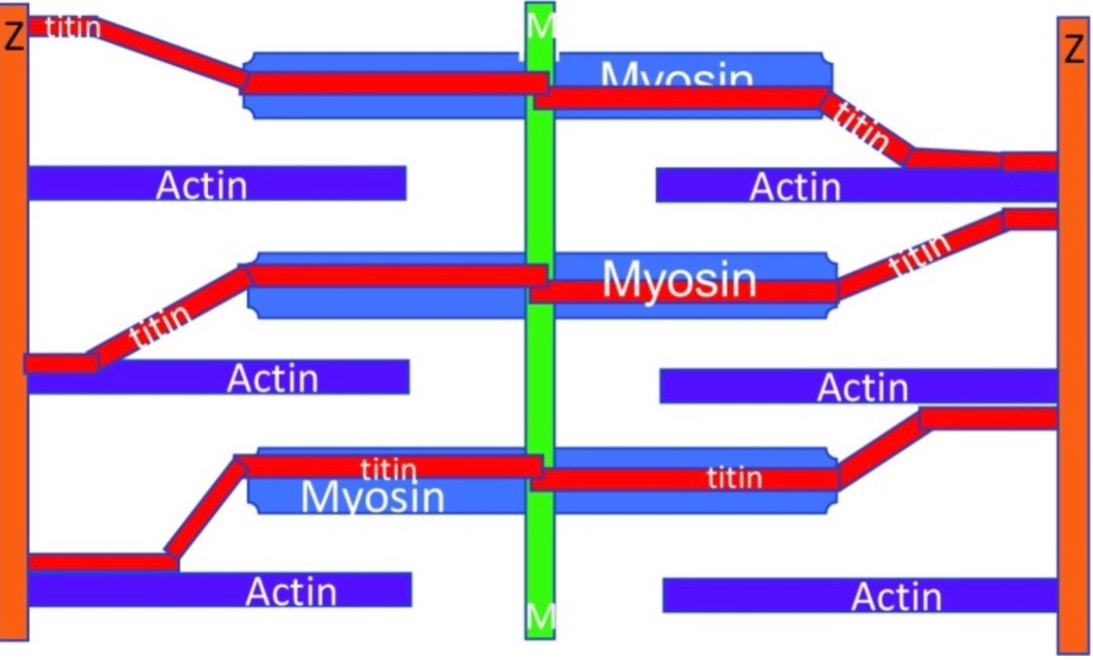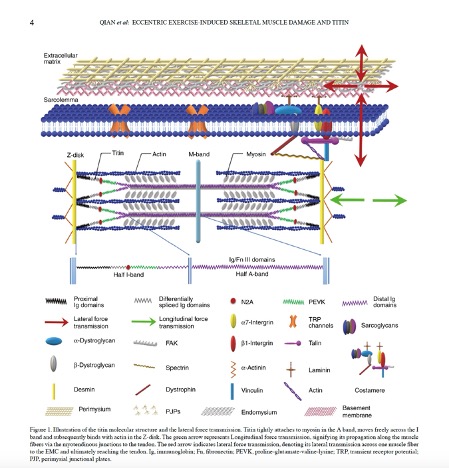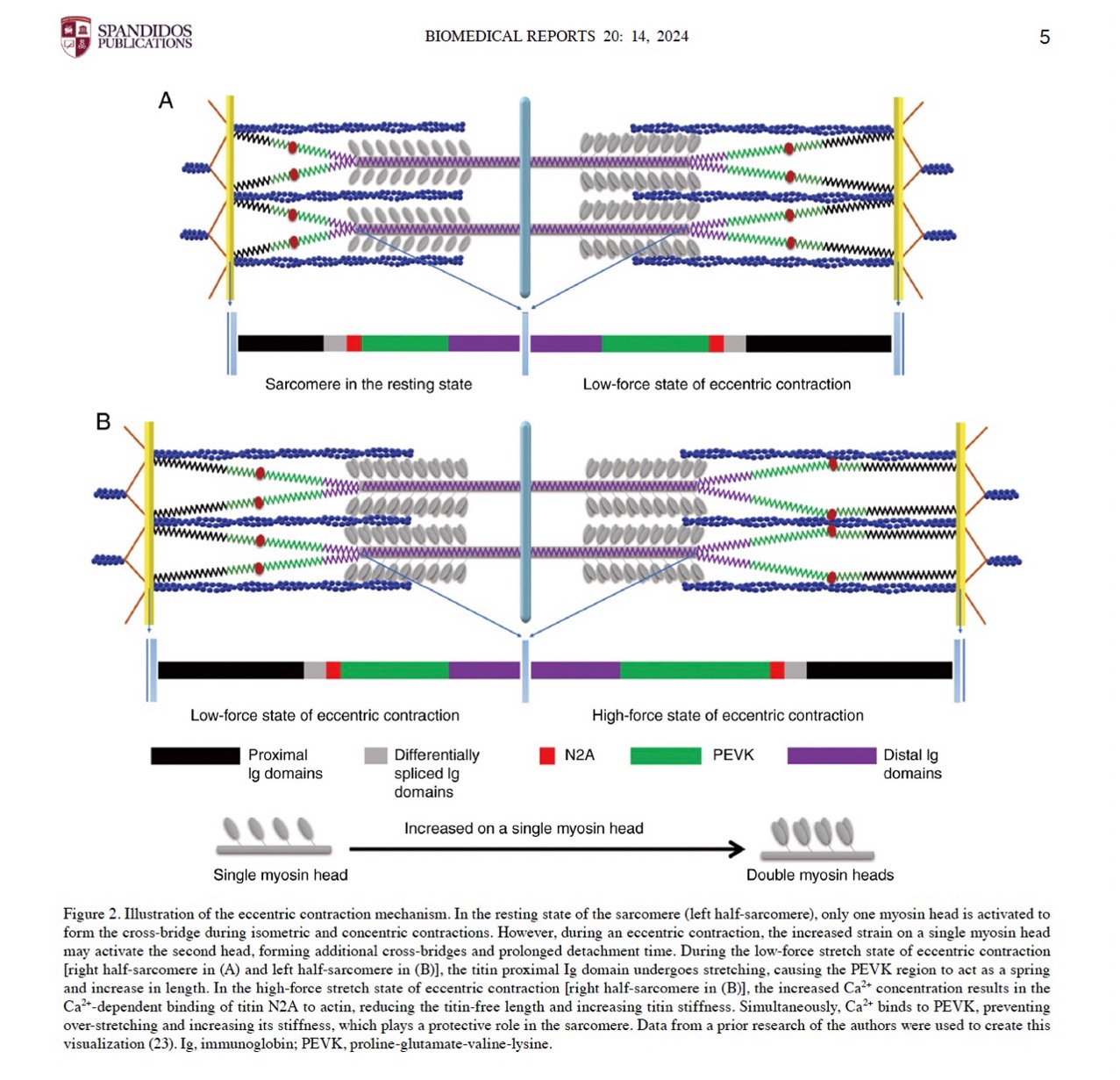Titin: The Titan of Proteins And Why Almost Zero Doctors Know it Exists
Titin: The Titan of Proteins And Why Almost Zero Doctors Know it Exists
Titin, the largest known protein in the human body, is a third protein interacting with actin and myosin in our sarcomeres. It is also not even mentioned during medical school. I never heard the name once while earning my Doctor of Physical Therapy Degree. I ask other medical practitioners (MD’s, DPT’s, DC’s, DO’s, AT’s) every weekend all over the country when I’m teaching them if they know of this protein, and maybe 1/40 people have heard the name. Zero people know anything about it. Why is this?
Must have been discovered too recently to be included in current curricula. Let’s see here, Titin was discovered in 1979, that’s 46 years ago. Hmmm… Well, don’t mind that lapse in updating what doctors learn about in school. It’s only been 46 years. And it’s not like 80% of the US population is overweight and sickly. Don’t worry, just know that the standard “comprehensive” metabolic blood panel, the current standard of “care” blood test approved by insurance in 2025, is the same test we used in the 1950’s. Remember guys, trust the self-proclaimed “public health” experts. They know stuff…
Anyway, titin plays a key role in our understanding of muscle structure, function, contraction, metabolism, and more. Titin spans the length of a sarcomere, the fundamental contractile unit of muscle, and acts kinda like a spring, providing both elasticity and stability to muscle fibers. Aside from supporting structural integrity, titin also affects energy efficiency, contractile strength, particularly with eccentric contraction, and more.
Titin is composed of repeating units interspersed with unique segments, allowing it to stretch and recoil within the sarcomere. This unique structure makes titin essential for maintaining sarcomere organization and resisting overstretching during muscle contraction.
Located in the sarcomere, titin connects the Z-disc, where the actin filaments anchor, to the M-line, the center of the myosin filament. It provides a passive restoring force, which brings the sarcomere back to its resting length following contraction or stretch. Unlike actin and myosin, the primary components of the sliding filament theory, the generally accepted model of muscle contraction taught in school, titin’s role has long been ignored, for no apparent reason. Research continues to highlight just how important titin is to understand if we actually want to know how muscles contract and relax. At the moment, everyone who assumes what they were taught in medical school was correct, or the whole story, is only aware of 2/3 of the proteins, that we know of, that make muscles work.
The two pictures below are referenced from: An historical perspective of the discovery of titin filaments: Biophys Rev. 2017 Jun;9(3):179-188. doi: 10.1007/s12551-017-0269-3.

Above Figure: The arrangement of myofilaments proposed by Carlsen et al. 1965 to explain their arrangement in highly stretched (≥4 μm) skeletal muscle sarcomeres. The red color indicates their proposed ‘gap’ filaments.

Above Figure: A model of the current knowledge of the arrangement of actin (purple), myosin (blue) and titin (red) filaments in the striated muscle sarcomere. Here, titin is shown as joining the Z disc to the M line, while making variable contact with the actin filaments.
Mainstream Medicine Mistakenly Assumes our Current Understanding of Human Biology, Neurophysiology, Healthspan, and Lifespan is Far More Comprehensive than it is.
If doctors know this little about how muscles contract, imagine the amount of stuff we don’t know about more complicated neurophysiology, like the intricate interaction and communication between muscles, which we somewhat understand, sort of, and the brain, which we hardly understand at all.
For example, we currently have “public health” agencies continuing to poison the public with new mRNA “vaccines” for things like the flu, RSV, Covid, and more stuff. Because they are way cheaper to make, and to hell with efficacy or safety! If I can give you the reader a single piece of health advice, here it is, please take this to heart. Injecting man-made, foreign mRNA genetic material into humans is criminal medical negligence. Getting said poison injected into you has exponentially more chance of destroying your genetic and epigenetic expression, autonomic nervous system homeostasis, health, and life, than it has of improving your health in any measurable way.
I have seen this needless, devastating destruction of health first hand with hundreds of my patients and students since 2020, and second hand through speaking to hundreds of doctors a month when I am teaching them. Not to mention objective reality and all objective data since 2020: life expectancy dropping for the first time in a century, “Sudden Death Syndrome,” heart attacks, strokes, and turbo cancer are now affecting young people for the first time in human history, including in pro athletes. And to top it all off, the little megalomaniac Anthony Fauci, the hell-spawned cretin who orchestrated everything to do with Covid, weirdly required a 10-year, retroactive, full pardon from everything he did, because of all the lives he and our criminal “public health” system so vehemently declare they saved. Or it’s that pesky fact about him being a serial killer… One or the other I guess…
There is no need for further discussion. No clinical trials are needed, I don’t care how the “vaccines” are made, I don’t care who says these “treatments” are “safe,” none of it matters. As long as you have a Bachelor-level education in biology or neurophysiology, which all Medical Doctors and Doctors of Physical Therapy do, and assuming you don’t have brain damage, you just need to understand one simple fact about our DNA. DNA that gets copied into RNA, which gets translated into proteins, then the proteins do stuff.
That fact is this: we currently think we understand 2-10% of our DNA and RNA, the 2-10% that codes for proteins. The CDC states this on their website, along with hundreds of papers. The other 90-98% of our DNA and RNA? Some genius labeled that our “junk” DNA, as though our failure to understand what it does means it does nothing. Stunning, Invincible ignorance. If it did nothing, if it wasn’t important, it wouldn’t be there, and removing it wouldn’t kill you.
If you knew in 2020 what you now know, that we think we understand how 2-10% of our genetic material works, and we know we have basically zero idea what the other 90-98% does or how it affects health, would you put alien mRNA into your body that is specifically created to hijack your DNA to RNA to Protein transcription and translation process and force your cells to make toxic proteins our body has never and would never create on its own? Just hoping the 90-98% of the stuff we are messing with, the stuff we know we know close to nothing about, doesn’t cause problems when interacting with the most complex systems in known in the universe, human beings?
Would you stick your arm in a hole in order to get a penny if someone told you there was a 2-10% chance you get the penny AND you keep your arm attached to your torso? Knowing those odds, the risk vs reward, risk being loss of arm, potential reward being 1 cent, what would you do? This is called informed consent, by the way. A term apparently unknown or simply disregarded in mainstream medicine and “public health.”
Titin’s Role in Muscle Function
- Passive Elasticity and Structural Integrity
Titin behaves like a spring, storing elastic energy during sarcomere stretching and releasing it upon recoil. This property is particularly important during eccentric contractions, where muscles lengthen under tension, a common occurrence during activities like running downhill, lowering a weight, or being drawn and quartered…The elastic recoil of titin facilitates energy-efficient force production. By stretching its tandem regions, titin provides a tunable stiffness, which varies depending on sarcomere length and calcium concentration, among other things.
- Active Contribution to Contraction
While traditionally seen as a passive player, titin actively contributes to muscle contraction. Recent studies show that titin’s stiffness increases upon calcium binding, aligning with sarcomere depolarization with muscle contraction. This “tunable” stiffness optimizes the transmission of force from myosin cross-bridges to the Z-disc, improving efficiency.On top of that, titin’s ability to bind to actin upon activation enhances its role in muscle force production. This interaction shortens the elastic region of titin, increasing its stiffness and enabling it to assist in force generation during contraction, as far a we can tell at the moment.
- The Winding Filament Hypothesis
One revolutionary concept is the “winding filament hypothesis,” which suggests that titin binds to actin and “winds” around it during contraction. This winding amplifies the force produced by the cross-bridges while minimizing energy expenditure. In this model, titin acts as a dynamic filament, contributing actively to muscle contraction rather than merely resisting stretch.

Qian, Z., Ping, L. and Xuelin, Z., 2023. Re examining the mechanism of eccentric exercise induced skeletal muscle damage from the role of the third filament, titin. Biomedical Reports, 20(1), p.14.

Qian, Z., Ping, L. and Xuelin, Z., 2023. Re examining the mechanism of eccentric exercise induced skeletal muscle damage from the role of the third filament, titin. Biomedical Reports, 20(1), p.14.
Titin’s Role in Energy Efficiency
A groundbreaking discovery has been titin’s capacity to generate mechanical work through the folding and unfolding of its structure. These domains act as molecular springs, storing and releasing energy during contraction. At forces below 10 piconewtons, the refolding of these domains can deliver substantial energy, more than the power stroke of a myosin filament.
This refolding mechanism allows titin to recover elastic energy during passive stretching, reducing the metabolic cost of muscle contraction. As a result, titin’s contribution to energy efficiency is vital for sustained muscle activity, particularly during repetitive or prolonged movements.
Applications in Exercise and Rehabilitation
Eccentric Exercise
Eccentric contraction, muscle lengthening under tension, is particularly beneficial for strengthening muscles and promoting tendon health, especially near end-range stretch. Titin’s ability to absorb energy and generate high force with low metabolic cost makes it central to the benefits of eccentric exercise. This form of exercise is widely used in rehabilitation for conditions like tendinopathy, sarcopenia, with astronauts to counteract muscle atrophy during low-gravity space travel, or simply to enhance muscle function and capacity.
Muscle Recovery and Injury Prevention
Titin’s elasticity plays a critical role in preventing muscle injuries caused by overstretching. By acting as a molecular shock absorber, titin reduces strain on other sarcomeric components, mitigating the risk of damage. Additionally, its role in maintaining sarcomere integrity accelerates recovery following muscle damage.
Titin’s Evolutionary Significance
Titin’s molecular design is a masterpiece of evolution, or intelligent design, or aliens, providing insights into muscle function across species. Its presence across animal kingdoms underscores its fundamental role in muscle physiology. Variations in titin’s isoforms allow for diverse muscle properties in different muscle types, Including skeletal, smooth, and cardiac muscle.
Possible Future Implications
Despite its enormous impact, many aspects of titin remain underexplored. And almost everything about titin, including the simple acknowledgement of its existence, is absent from current Physical Therapy and other medical school curricula.
- Titin Mutations and Disease: Mutations in the titin gene or genes which encode for the titin protein are linked to cardiomyopathies, skeletal myopathies, and other muscle disorders. Understanding these mutations could unlock new therapeutic treatments.
- Titin’s Role in Aging and Peptide Therapy: As we age, titin’s properties may change, contributing to declines in muscle elasticity and strength. Research into titin-targeted interventions could help mitigate these effects.
- Biomimicry and Biotechnology: Titin’s unique mechanical properties inspire innovations in materials science, including the development of bioengineered tissues and nanotechnology.
Conclusion
Titin’s role in muscle physiology cannot be overstated. The incoherent buffoonery of not teaching this in school cannot be understated. From maintaining sarcomere integrity to optimizing energy efficiency and facilitating eccentric contraction, titin is an indispensable component of our sarcomeres and muscles. As research continues to uncover its mysteries, titin has the potential to revolutionize our understanding of muscle biology and inform advancements in medicine, exercise science, and biotechnology. If we ever decide to teach people about it, that is…
For now, titin remains a testament to the elegance and complexity of the human body’s molecular machinery, a true giant, the titan of proteins.
References
- Journal of Sports Science and Medicine (2022) 21, 536-544. http://www.jssm.org DOI: https://doi.org/10.52082/jssm.2022.536
- Harris-Love, M.O.; Gollie,J.M.; Keogh, J.W.L. Eccentric Exercise: Adaptations and Applications for Health and Performance. J. Funct.Morphol. Kinesiol. 2021, 6, 96. https://doi.org/10.3390/jfmk6040096
- Pflügers Archiv – European Journal of Physiology (2023) 475:421–435. https://doi.org/10.1007/s00424-023-02794-z
- Qian, Z., Ping, L. and Xuelin, Z., 2023. Re‑examining the mechanism of eccentric exercise‑induced skeletal muscle damage from the role of the third filament, titin. Biomedical Reports, 20(1), p.14.
- Why exercise builds muscles: titin mechanosensing controls skeletal muscle growth under load. Biophysical Journal 120, 3649–3663, September 7, 2021. https://doi.org/10.1016/j.bpj.2021.07.023
- Hessel, A. L., Lindstedt, S. L., & Nishikawa, K. C. (2017). Physiological Mechanisms of Eccentric Contraction and Its Applications: A Role for the Giant Titin Protein. Frontiers in Physiology, 8(70). doi: 3389/fphys.2017.00070.
- Rivas-Pardo, J. A., Eckels, E. C., Popa, I., Kosuri, P., Linke, W. A., & Fernández, J. M. (2016). Work Done by Titin Protein Folding Assists Muscle Contraction. Cell Reports, 14(6), 1339–1347. doi: 1016/j.celrep.2016.01.025.
DISCLAIMER: The content on the blog for Intricate Art Spine & Body Solutions, LLC is for educational and informational purposes only, and is not intended as medical advice. The information contained in this blog should not be used to diagnose, treat or prevent any disease or health illness. Any reliance you place on such information is therefore strictly at your own risk. Please consult with your physician or other qualified healthcare professional before acting on any information presented here.
Stay Engaged With Intricate Art
Get the latest news, updates and offers from Intricate Art delivered to your inbox.